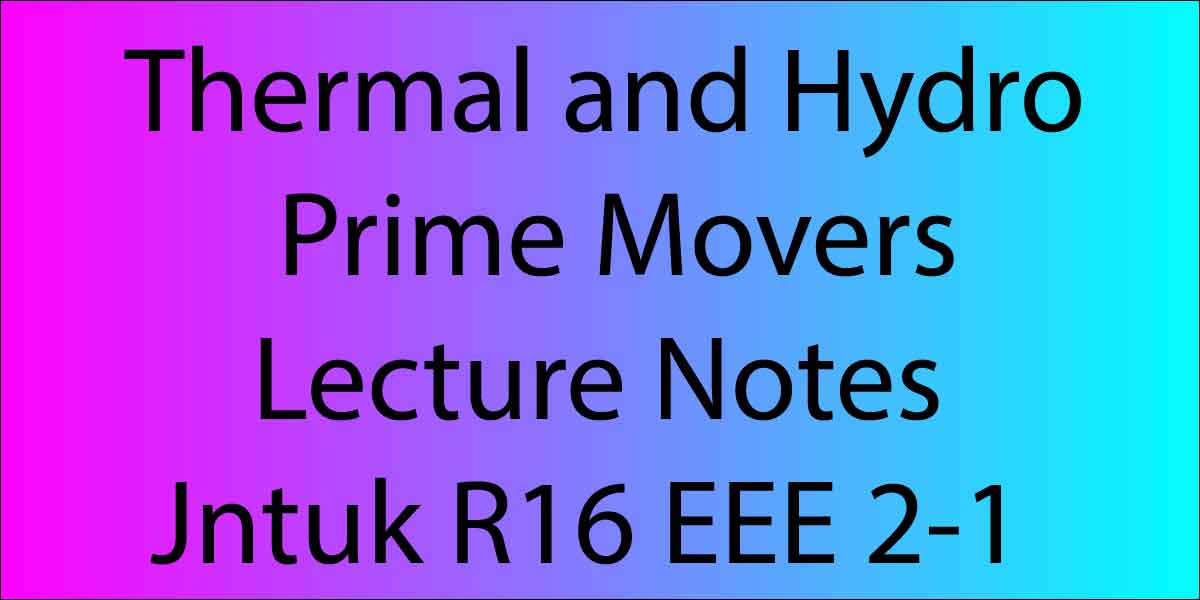Thermal and Hydro Prime Movers
Part-A: Thermal prime movers
Course Objectives:
to create the coed perceive the kinds of prime movers, which may be connected to generators for power production and will get the talents of playing the required calculations with reference to the functioning of the prime movers.
UNIT I:
Objectives: to create the coed find out about the constructional options, operational details of assorted kinds of combustion engines through the main points of many engine systems and therefore the basic air customary cycles, that govern the engines. Further, the coed shall be able to calculate the performance of various kinds of combustion engines.
I.C Engines: Classification, operating principles – valve and port temporal arrangement diagrams – air customary cycles – Engine systems line fuel injection system, carburetion, ignition, cooling and lubrication – Engine performance analysis.
UNIT II:
Objectives: to coach the coed within the aspects of steam formation and its utilities through the quality steam knowledge tables and charts. to create the coed correlate between the air customary cycles and therefore the actual cycles that govern the steam turbines. to coach the coed to calculate the performance of steam turbines exploitation speed diagrams.
Properties of Steam and use of Steam Tables- T-S and H-S Diagrams. Analysis of assorted physical science Processes underneath gone Steam. Vapor Power Cycles: Carnot Cycle-Rankine Cycle- physical science Variables Effecting potency and output of temperature unit Cycle-. Analysis of straightforward temperature unit Cycle and Re-heat cycle Steam Turbines: Schematic layout of steam station Classification of Steam Turbines- turbine and Reaction Turbine- combination in Turbines- speed Diagrams for easy Impulse and Reaction Turbines- Work done
UNIT III:
Objectives: To impart the information of turbine fundamentals, the governing cycles and therefore the ways to boost the potency of gas turbines.
Gas Turbines: easy turbine plant-ideal cycle, closed cycle -open cycle-. Efficiency, Work magnitude relation and optimum pressure magnitude relation for easy turbine cycle. Actual cycle, analysis of straightforward cycles & cycles with entomb cooling, reheating and Regeneration Part-B: Hydro prime movers
UNIT IV:
Objectives: to show the coed regarding the elemental of fluid dynamic equations and its applications fluid jets. To impart the information of assorted kinds of pumps, their constructional options, operating and performance.
IMPACT OF JETS AND PUMPS: Impulse momentum equation, Impact of Jet on stationary and moving vanes (flat and curved). Pumps: kinds of pumps, Centrifugal pumps: Main elements, working rule, Multi stage pumps, Performance and characteristic curves
UNIT V:
Objectives: to create the coed find out about the constructional options, operational details of assorted kinds of hydraulic turbines. Further, the coed shall be able to calculate the performance of hydraulic turbines.
HYDRAULIC TURBINES: Classification of turbines; working rule, potency calculation and style principles for Pelton Wheel, Francis and for Kaplan turbines; Governing of turbines; Performance and characteristic curves.
UNIT VI:
Objectives: to coach the coed within the areas of kinds of hydro wattage plants, estimation and calculation varied} hundreds by considering various factors.
HYDRO POWER: elements of Hydro wattage plant: tense storage systems, Estimation of water power potential; Estimation of load on turbines: load curve, ratio, capability issue, utilization issue, diversity issue, load – period curve, firm power, secondary power, prediction of load.
Text Books:
one. Thermal Engineering by Hindustani, Lakshmi publications a pair of. Thermal engineering by M.L.Mathur and F.S.Mehta, religious belief Brothers.
3. “Hydraulics & Fluid Mechanics”, P.N. Modi and S.M. Seth, TEXT BOOKS House, Delhi
4. “Fluid Mechanics & Hydraulic Machinery” A.K.Jain, , Khanna Publishers, Delhi.
Reference Books:
one. “Fluid Mechanics” by Victor.L.Streeter
2. “Introduction to Fluid Mechanics” Edward .J. Shaughnessy Jnr.
3. “Fluid Mechanics & Its Applications”, Vijay Gupta, Santhosh.k.Gupta
4. “Fluid Mechanics & Fluid power Engineering, Dr D.S.Kumar
5. “Water Power Engineering” M.M Desumuk.

